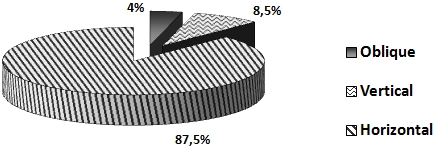СВЯЗЬ РЕНТГЕНОГРАММ ГРУДНОЙ КЛЕТКИ С СОМАТОТИПОМ ЮНОШЕЙ
Коротаева А.Э.1, Гаряев П.А.2
1Студент, 2Кандидат медицинских наук, Пермский государственный медицинский университет имени Е.А. Вагнера
СВЯЗЬ РЕНТГЕНОГРАММ ГРУДНОЙ КЛЕТКИ С СОМАТОТИПОМ ЮНОШЕЙ
Аннотация
В статье сопоставлены типы телосложения студентов Пермской медицинской академии с рентгенограммами их грудной клетки.
Ключевые слова: рентгенограмма, соматотип, КТИ, положение сердца.
Korotaeva A.E.1, Garyaev P.A.2
1Student, 2Candidate of Medical Sciences, Perm State Medical University named after E.A.Vagner
CONNECTION BETWEEN THE THORAX SKIAGRAM AND THE SOMATOTYPE OF YOUNG MALES
Abstract
The article considers the finding correlation between the somatotype of the Perm state medical academy students and the skiagram of their thorax
Keywords: skiagram, somatotype, CTI, position of the heart.
For a long time the problem of body type in Human Anatomy has been a subject of many fundamental and empirical medical studies. Every researcher interprets the main ideas of the body organization science in his own way on the basis of the subject and object of the investigation according to the aim and objectives set by him. Let us present our own vision of the problem
The aim of the work is finding correlation between the somatotype of the Perm state medical academy students and the skiagram of their thorax.
Objectives:
- To examine the theoretical and applied literature on the subject of the research.
- To define somatotypes of examined students.
- To measure the skiagram of the thorax.
- To correlate the measurement of the thorax with the definite somatotype and make a conclusion.
Methods.
The investigation is based on the method of study and analysis the literature on the subject, visual and comparative anatomical methods used in the experimental part of the research. Identification of the somatotype (Pignet Index), study of the thorax skiagram (frontal view).
Results:
It was discovered that the asthenics predominantly have oblique or vertical position of the heart (40%). The students of the hypersthenic habitus generally have a horizontal position of the heart (87.5%), while oblique and horizontal position of the heart is prevailing for the normosthenic type (43.5%).

Fig. 1 - Position of the heart of the asthenics

Fig. 2 - Position of the heart of the hypersthenics

Fig 3 - Position of the heart of the normosthenics
In accordance with the results (findings) of the research it was discovered that the young males with the asthenic habitus tend to have the decreasing CTI (CTI ≈ 30%). The number of such students makes up 60%. The hypersthenics are noticed to have the increasing CTI (75% of students – CTI ≈ 40%). The normosthenics' CTI varies. The index of 61% of the examined is > 40%, 35% –> 30% and one student's CTI (4%) is < 30%.

Fig. 4 - CTI of the asthenics

Fig. 5 - CTI of the hypersthenics

Fig. 6 - CTI of the normosthenics
Besides, thickness of the soft issues was measured. It was ascertained that the students of the asthenic and normosthenic types have moderate adipopexia (the average number is 0.76 and 0.75). The ones with the hypersthenic habitus are more prone to adipopexia; their index is lower than the asthenics' one (0.7).
The measurement of the thorax showed that the asthenics had a tendency to the lengthening of the thorax. The relation between longitudinal and transversal diameters of the thorax was 1,75 (length of the thorax is about twofold of its half- width), the hypersthenics Had a flatter thorax in inferior-superior direction. Length of the thorax is close to its half- width (1,2). The Normosthenics have a tendency to imperceptible lengthening of the thorax. The Average data of this index = 1,57.
Conclusion
This findings of thorax measurement confirm the generally accepted characteristic of each particular somatotype, that might be evidence of integrity of this experimental work.
References
- Lindenbraten L. D., Naumov L. B. Medicinskaja rentgenologija. – 2-e izd., pererab. i dop. – M.: Medicina, 1984, 384 s., il.
- Anatomija cheloveka /Pod red. M.R. Sapina. M.: Medicina, t.1, t. 2, 1986.
- Sinel'nikov R.D. Anatomija cheloveka. Pod red. M.R.Sapina. T.1-4. 1996.
- Ostroverhov G.S., Bomash Ju.M., Lubockij D.M. Operativnaja hirurgija i topograficheskaja anatomija. 4-e izd. Dop. — 1995.
